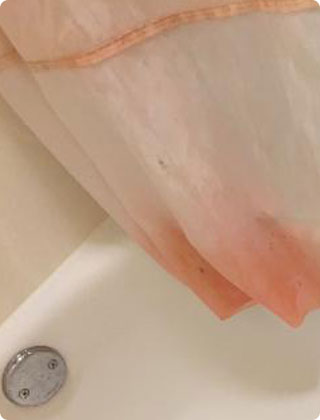MENU


When people express concerns about indoor mold, they will readily describe mold as a black or green substance, with a distinctive musty odor that heralds its presence. Red mold, while not as notorious as its dark-hued relatives, can also be problematic, posing significant health risks for allergic individuals.
Red mold isn't a scientific name; it describes various mold species that all have a red or orange hue. These include Serratia marcescens, often found in bathrooms and other high-moisture areas, and Neurospora, often seen on foods like bread or cheese.
Now, why the color red? The pigment, a response to environmental factors, serves as a shield against light and radiation - think of it as mold's version of sunscreen. But don't let its flamboyant appearance fool you; red mold is as serious as its dull-colored cousins when it comes to the need for removal.
Keep in mind that not all red-colored growths are mold. Sometimes, what seems like mold could be bacteria (Serratia marcescens is one example). If you are ever in doubt whether that red discoloration is mold or not, professional mold testing will give you a definitive answer.
If you're looking for signs of mold in your home, make sure to keep an eye out for red mold as well.
Color: This mold is a bright red or orange, and may look like a stain or discoloration on tiles or grout.
Moisture: Mold readily grows in areas where it stays damp, like basements and bathrooms. Kitchens are also susceptible due to steam generated during cooking.
The Sniff Test: Can't see it yet? Your nose might come to the rescue. Red mold comes with a musty, old-library-book kind of smell.
A Touchy Topic: If you ever get close enough (but really, you shouldn't touch it), it's got a texture that can range from a slimy film to a fuzzy coat, much like its mold cousins.
Risk to Good Health: Red mold might not be the most dangerous type of mold, but it can still play havoc with your indoor air and cause problems for anyone with allergies or respiratory issues.
Right Conditions for Mold: Spotting red mold indicates that there are almost certainly other mold types around, as mold grows readily in wet conditions, regardless of the type.
Red mold in the bathroom is more than a visual nuisance; it can also cause health concerns you need to know about.
Red mold can be an irritant for those who are more sensitive, causing sneezing fits, itchy eyes, and a runny nose. And if you or someone in your family has asthma, it can turn any ordinary day into a struggle for breath.
Here's where things get a bit more serious. Red mold itself does not produce mycotoxins, but the same conditions that support this mold can support molds that do produce mycotoxins, nasty little compounds that can make you feel pretty lousy and, in extreme cases, can be downright dangerous.
For those with immune systems that aren't at their fighting best - like the elderly, kids, or anyone battling chronic illnesses - red mold can be more than just a nuisance. It can lead to infections and health problems that are harder to shake off.
Sometimes even just touching a moldy surface can cause your skin to become irritated.
There's also the stress that comes with finding mold in your home. It's not just about cleaning it up; it's the worry about health, the cost of removal, and just the general feeling of 'ugh' that can weigh on your mind.
Dealing with red mold in your home can sometimes feel like you're in a never-ending game. Just when you think you've got it under control, it pops up again. That's your cue to bring in the professionals. Recognizing when you need to switch from a DIY approach to calling in the experts can save you a lot of hassle (and potential sneezes).
O2 Mold Testing specializes in professional mold inspection, focusing on the critical need for consistent moisture level monitoring and employing sophisticated detection methods to avert red mold infestations in residential and commercial properties.
Understanding the scope and nature of a mold issue is crucial, especially when dealing with potentially harmful types like red mold. Professional testing provides you with the facts, so you can address the issue properly and keep your home safe and healthy.
Health Concerns: Without proper precautions, DIY efforts can disturb mold, releasing spores into the air. This is especially concerning for those with asthma, allergies, or other respiratory issues.
Incomplete Mold Detection: Surface mold is often just the tip of the iceberg. What lies beneath might be a bigger, more entrenched problem. Sometimes, red mold is a sign of deeper issues, like hidden leaks or water damage. Without a professional eye, these problems can go unnoticed and unaddressed.
Cross-Contamination Risk: Without the right techniques, you might unintentionally spread mold to other parts of your home.
By adopting these eco-friendly strategies, you're not just keeping your home mold-free; you're doing it in a way that's harmonious with nature. It's all about smart, simple actions that make your home a healthier, happier place to be. Here's to embracing the natural way of life, free from the clutches of red mold! 🌿
Mold impacts the air quality inside your home. This can have significant effects for your comfort and health.
When mold has moisture and materials to feed it, it becomes a factory for producing spores. It's constantly releasing these microscopic particles into the air, and in a cozy, closed-up home, they're just floating around, waiting to be inhaled.
Red mold spores are invisible allergens, triggering reactions like sneezing, coughing, or itchy eyes. And if someone in your house has asthma, these spores can turn a regular day into a wheezy, uncomfortable one.
Even if you're not usually allergy-prone, a constant barrage of these spores can irritate your eyes, skin, and lungs, making your home feel a little less homey.
Apart from its health impacts, red mold brings along a musty odor that can make your house smell like a forgotten basement. This smell is also a sign that your home might be a bit on the damp side, which isn't great for air quality.
If mold takes hold in your HVAC system, it becomes very easy for mold to spread to every room in your home, and even to grow where there is a little bit of moisture.
Keeping your HVAC system clean ensures that the air circulating through your home is as clean as possible.
Living with mold over the long haul can be more than just annoying; it can seriously mess with your health. For the very young, the elderly, or anyone with a weakened immune system, it's especially risky.
Continuous exposure might lead to more serious health troubles down the line, so it's not something to take lightly.
The best way to deal with red mold is to stop it from showing up in the first place. Regular cleaning, controlling humidity, and fixing leaks promptly are key to mold prevention.
In this epic battle against red mold, knowledge and vigilance are your best allies. Keep your shields up (and your bathrooms dry), and you'll keep your home a mold-free sanctuary. And if things get out of hand, don't hesitate to call our professional mold testing company. Stay safe, stay mold-free!